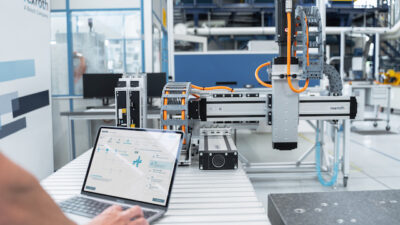It can be very difficult for end-users or OEMs considering relatively new or unfamiliar technologies to decide when, what type, and how much of it to implement. Engineering, marketing and management personnel are often sharply divided on which option is best, as well as which solution is most useful and desired by customers.
It can be very difficult for end-users or OEMs considering relatively new or unfamiliar technologies to decide when, what type, and how much of it to implement. Engineering, marketing and management personnel are often sharply divided on which option is best, as well as which solution is most useful and desired by customers.
Staffers at R.A. Jones (Covington, Ky.) recently underwent this process when management decided its packaging machine product needed to include software-based PLC controls for its servo-driven motion functions, sequencing, and I/O devices. Jones builds and sells about 50 of its Pouch King, Criterion, and Maxim packaging machines annually for about $500,000 each. Most control functions are carried out via a human-machine interface (HMI) and related software.
Too little to just right
Fenton Painter, R.A. Jones’ electrical engineer, says the company first spent three months vainly trying to implement a new HMI control based on a DOS real-time kernel. This product wasn’t stable enough to meet R.A. Jones’ requirements.
R.A. Jones’ engineers then selected WinAC/RTX from Siemens Energy & Automation (Alpharetta, Ga.), which operates via a Profibus network, and includes a real-time operating system for Windows NT from VenturCom.
“It was able to deliver the scan times we wanted, had a good instruction set, and was able to meet our cost and performance projections,” says Mr. Painter. “In fact, we reduced the hardware cost of each machine by $1,000 because less PLC hardware was needed. Our hardware-based PLC had better performance, but it also costs more to buy and mount.”
Transition struggle
The dilemma faced by R.A. Jones was that, even though traditional PLCs are reliable, and present few risks, the firm’s management knew demand for software-based PLCs was likely to grow in the future. R.A. Jones had to offer software-based PLCs, even though they’re presently accompanied by many of the same problems that occur in commercial software, such as debugging, lacking support, and version incompatibility.
“Software-based PLCs can be dangerous because Microsoft NT isn’t as stable as it could be, especially in machine control,” says Mr. Painter. In this implementation, “We found PCs running NT aren’t as reliable as hardware PLCs with proprietary software. And every time PC hardware or software changes, we get integration problems not typically seen with traditional PLCs,” he adds.
Likewise, R.A. Jones’ customers still specify hardware PLCs eight-to-one over software-based PLCs among all packaging machines ordered.
“This caused a lot of conflict and personality issues because our engineering, marketing people said our customers didn’t want software-based PLC control. However, management wanted it, and invested about $100,000 to develop and implement it and another $40,000 to maintain it, even though current sales didn’t justify it,” adds Mr. Painter. “So, we developed a machine with software-based PLC control, which means we now support two standard machines, and our customers can get either flavor.
“We still have a lot of arguments about hardware- versus software-based PLCs. However, maybe developing controls with software-based gives us a little bit of an edge in how we’re perceived,” he surmises.
Past is prologue
Remarkably, the present debate parallels what happened when hardware PLCs were the new technology on the block. “I remember in the early 1980s that some companies built completely redundant relay panels to backup PLCs because they were afraid the PLCs wouldn’t work,” says Mr. Painter. “PLCs had a lot of bugs then, but they delivered flexibility that relay panels couldn’t match. Of course, this is similar to the added flexibility that software-based PLCs promise today, such as increased processing speed, data availability, and Internet connectivity.
Jim Montague, news editor [email protected]



